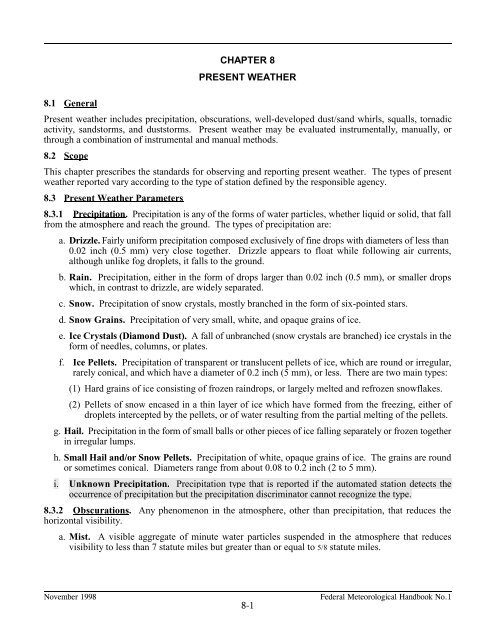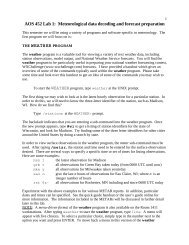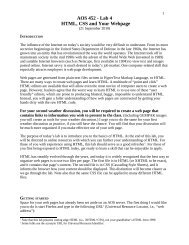Federal Meteorological Handbook No. 1 - Marrella
Federal Meteorological Handbook No. 1 - Marrella
Federal Meteorological Handbook No. 1 - Marrella
Create successful ePaper yourself
Turn your PDF publications into a flip-book with our unique Google optimized e-Paper software.
8.1 General<br />
CHAPTER 8<br />
PRESENT WEATHER<br />
Present weather includes precipitation, obscurations, well-developed dust/sand whirls, squalls, tornadic<br />
activity, sandstorms, and duststorms. Present weather may be evaluated instrumentally, manually, or<br />
through a combination of instrumental and manual methods.<br />
8.2 Scope<br />
This chapter prescribes the standards for observing and reporting present weather. The types of present<br />
weather reported vary according to the type of station defined by the responsible agency.<br />
8.3 Present Weather Parameters<br />
8.3.1 Precipitation. Precipitation is any of the forms of water particles, whether liquid or solid, that fall<br />
from the atmosphere and reach the ground. The types of precipitation are:<br />
a. Drizzle. Fairly uniform precipitation composed exclusively of fine drops with diameters of less than<br />
0.02 inch (0.5 mm) very close together. Drizzle appears to float while following air currents,<br />
although unlike fog droplets, it falls to the ground.<br />
b. Rain. Precipitation, either in the form of drops larger than 0.02 inch (0.5 mm), or smaller drops<br />
which, in contrast to drizzle, are widely separated.<br />
c. Snow. Precipitation of snow crystals, mostly branched in the form of six-pointed stars.<br />
d. Snow Grains. Precipitation of very small, white, and opaque grains of ice.<br />
e. Ice Crystals (Diamond Dust). A fall of unbranched (snow crystals are branched) ice crystals in the<br />
form of needles, columns, or plates.<br />
f. Ice Pellets. Precipitation of transparent or translucent pellets of ice, which are round or irregular,<br />
rarely conical, and which have a diameter of 0.2 inch (5 mm), or less. There are two main types:<br />
(1) Hard grains of ice consisting of frozen raindrops, or largely melted and refrozen snowflakes.<br />
(2) Pellets of snow encased in a thin layer of ice which have formed from the freezing, either of<br />
droplets intercepted by the pellets, or of water resulting from the partial melting of the pellets.<br />
g. Hail. Precipitation in the form of small balls or other pieces of ice falling separately or frozen together<br />
in irregular lumps.<br />
h. Small Hail and/or Snow Pellets. Precipitation of white, opaque grains of ice. The grains are round<br />
or sometimes conical. Diameters range from about 0.08 to 0.2 inch (2 to 5 mm).<br />
i. Unknown Precipitation. Precipitation type that is reported if the automated station detects the<br />
occurrence of precipitation but the precipitation discriminator cannot recognize the type.<br />
8.3.2 Obscurations. Any phenomenon in the atmosphere, other than precipitation, that reduces the<br />
horizontal visibility.<br />
a. Mist. A visible aggregate of minute water particles suspended in the atmosphere that reduces<br />
visibility to less than 7 statute miles but greater than or equal to 5/8 statute miles.<br />
������������� ������������������������������������<br />
���





